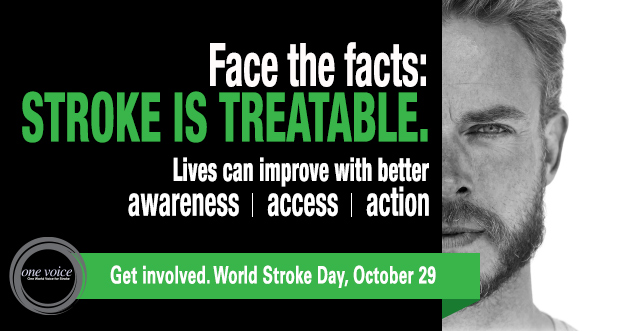World Stroke Day
October 29, 2016

World Stroke Day is observed globally on October 29 every year to highlight the serious nature and high rates of stroke, raise awareness of the prevention and treatment of the condition and provide better care and support for survivors. This event was started in 2006 by the World Stroke Organization (WSO)
Campaign for 2016 – “Stroke is Treatable”

Theme for 2016 – “Face the Facts“
What is stroke?
A stroke is a “brain attack”. It can happen to anyone at any time. It occurs when blood flow to an area of brain is cut off. When this happens, brain cells are deprived of oxygen and begin to die. When brain cells die during a stroke, abilities controlled by that area of the brain such as memory and muscle control are lost.
Types of Stroke
The Centers for Disease Control and Prevention (CDC) lists three main types of stroke:
- The Centers for Disease Control and Prevention (CDC) lists three main types of stroke:
- Hemorrhagic Stroke – caused by ruptured blood vessels that cause brain bleeding.
- Ischemic Stroke – caused by blood clots.
- Transient Ischemic Attack (TIA) – a “mini-stroke,” caused by a temporary blood clot.
According to the American Heart Association (AHA), the vast majority of strokes (87 percent) are Ischemic strokes.
Stroke Symptoms
- numbness or weakness that starts suddenly, most commonly on either the left or right side of the body (face, arms, or legs are often affected).
- confusion, difficulty comprehending language, or trouble talking that begins without warning.
- sudden vision problems (in one eye or both).
- severe, piercing headache, with no clear cause, that starts suddenly.
- difficulty walking because of sudden loss of balance or dizziness.
How to prevent?
Strokes are often deadly—but they can be prevented. The National Stroke Association (NSA) states that around 80 percent of all strokes can be avoided by taking some steps:
- check your blood pressure and cholesterol levels regularly
- don’t smoke, and drink alcohol only in moderation.
- eat a low-fat, low-salt diet.
Managing your risk for stroke with simple but important lifestyle changes can go a long way towards prevention.
Stroke Myths & Facts
MYTH: Stroke cannot be prevented.
FACT: Up to 80 percent of strokes are preventable.
MYTH: There is no treatment for stroke.
FACT: At any sign of stroke medical emergency immediately. Treatment may be available.
MYTH: Stroke only affects the elderly.
FACT: Stroke can happen to anyone at any time.
MYTH: Stroke happens in the heart.
FACT: Stroke is a “brain attack”.
MYTH: Stroke recovery only happens for the first few months after a stroke.
FACT: Stroke recovery is a lifelong process.
MYTH: Strokes are not hereditary.
FACT: Family history of stroke increases your chance for stroke.
MYTH: If stroke symptoms go away, you don’t have to see a doctor.
FACT: Temporary stroke symptoms are called transient Ischemic attacks (TIA). They are warning signs prior to actual stroke and need to be taken seriously.
Source: www.stroke.org / www.healthline.com / www.en.wikipedia.org
Image Credit: www.rocknrecovery.net / www.believingtampa.com


